Tanning Bed Before Buying: 10 Key Tips
Choosing the right tanning bed is an important decision for anyone who wants a golden, healthy-looking tan at home or in a professional setting. A tanning bed is not just a machine—it’s an investment in your appearance, comfort, and safety. Making the right choice can influence how even and deep your tan is, how safe the experience feels, how much maintenance is required, and how cost-effective it will be in the long term. This guide will help you understand what to look for by breaking down ten critical considerations, including bed type, size, power, skin compatibility, safety features, maintenance, cost, brand reputation, additional features, and after-sales support. By the end of this article, you will be well-equipped to make a confident and informed choice.
Table of Contents
Why Your Tanning Bed Choice Matters
- The tanning bed you choose can dramatically affect your results and experience. A high-quality bed ensures that you achieve a beautiful, even tan without risking burns or uneven patches. Safety is another crucial factor, as UV exposure carries risks such as premature skin aging, eye damage, and increased risk of skin cancer. Furthermore,
- The right bed impacts cost-effectiveness. Beyond the initial purchase, you need to consider electricity usage, maintenance, replacement lamps, and space requirements. Choosing a bed carefully will save you from unexpected expenses and frustration.
Understanding the Variety of Tanning Beds on the Market
The market offers a wide variety of tanning beds to suit different needs. Home beds are designed for occasional use and typically have fewer lamps with lower power output. Commercial or salon-grade beds are built for frequent use and provide higher UV intensity for faster results. Within these categories, you will also find horizontal (lie-down) beds and vertical (stand-up) booths. Horizontal beds offer comfort and full-body coverage, while stand-up units often provide more even tanning and are easier to clean and maintain. Specialty beds, including high-pressure units and hybrid models with red-light therapy, are also available for those looking for faster results or added skin benefits.
Setting Realistic Expectations Before Buying
Before investing in a tanning bed, it is essential to consider your budget, available space, and how often you plan to use it. Home beds require less space and cost less, but if you plan to tan frequently, a commercial-style bed may provide better performance and durability. Take measurements of your space and consider ventilation and electrical requirements. Being realistic about these factors will prevent disappointment and help you choose a bed that truly meets your needs.
1. Type of Tanning Bed
Low-Pressure vs. High-Pressure Beds
Low-pressure tanning beds emit a combination of UVA and UVB rays, which produces a gradual, slower tan. They are ideal for those who prefer a safer, more controlled tanning experience. High-pressure beds, on the other hand, focus on stronger UVA rays and provide faster, deeper tanning results in shorter sessions. Choosing between these options depends on your desired outcome and skin sensitivity.
Horizontal vs. Vertical (Stand-Up) Beds
Horizontal beds are the traditional type where you lie down and a canopy closes over you. They are usually more spacious and provide consistent coverage. Vertical or stand-up beds allow you to stand during tanning, offering convenience, better hygiene, and even exposure to UV light. Stand-up units are particularly useful in smaller spaces or for users who prefer a faster tanning session.
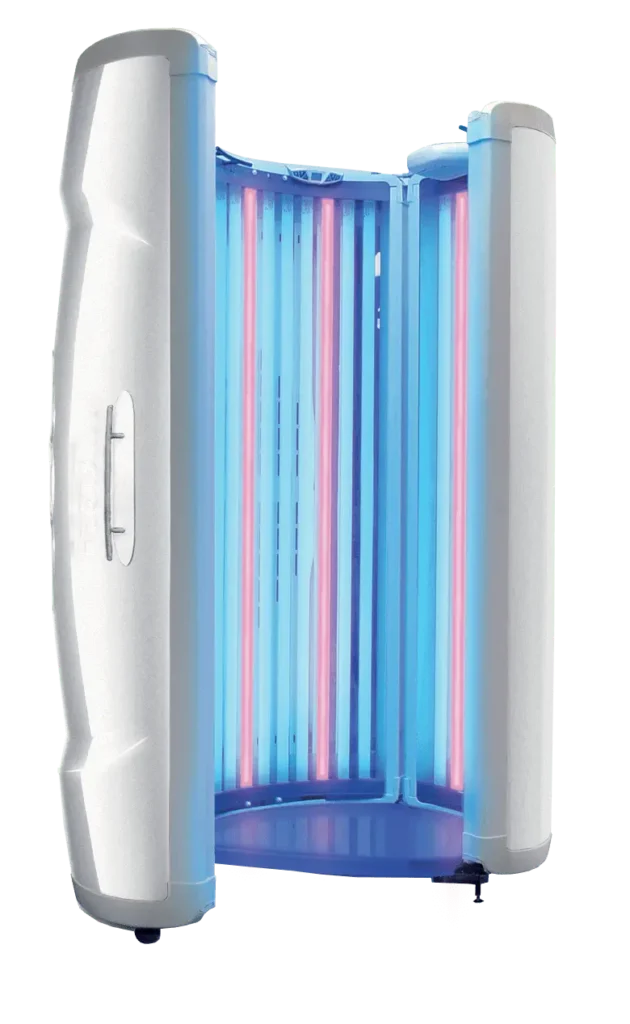
Specialty Beds with Red Light or Hybrid Technology
Modern tanning beds may include hybrid options that combine traditional UV tanning with red-light therapy. These beds aim to enhance skin benefits such as improved texture, collagen production, and overall skin health alongside your tan. LED or red-light features can provide a gentler tanning experience while adding rejuvenation benefits.
2. Bed Size and Space Requirements
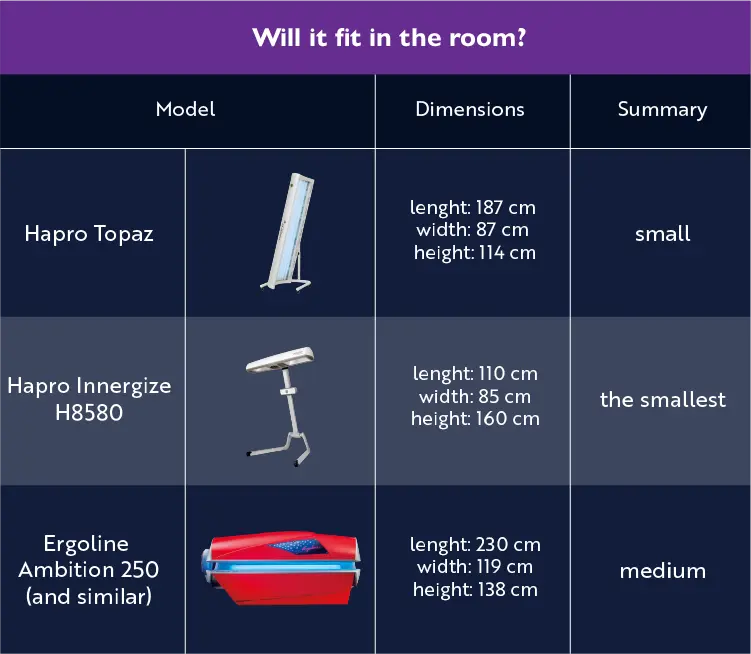
Measuring Available Space at Home
Before purchasing, measure the available floor space, ceiling height, and ensure there is adequate room for proper ventilation. Keep in mind that horizontal beds need enough clearance for the lid to open fully. Additionally, consider the location of electrical outlets and ensure they meet the voltage requirements of the bed.
Compact vs. Full-Size Beds
Compact beds are perfect for smaller rooms but may have fewer lamps and lower tanning intensity. Full-size beds are more comfortable and provide a more even tan, but they require more space. The choice depends on the balance between space availability and your tanning needs.
Mobility and Installation Needs
Consider how easy it will be to install and move your tanning bed. Many beds are heavy and require at least two people to assemble. Check for portability options, the need for specific electrical circuits, and floor strength if the bed is heavy. Some units are designed for easier assembly and relocation, which can be useful for future room rearrangements.
3. Power and Lamp Type
Understanding Wattage and Power Output
The power and wattage of a tanning bed affect tanning speed, efficiency, and energy consumption. Higher wattage means faster tanning sessions but also increased electricity usage. Home beds often use standard household voltage, while commercial beds may require heavier-duty circuits.
Fluorescent vs. LED Lamps
Most traditional beds use fluorescent lamps that provide a mix of UVA and UVB rays. LED tanning beds or hybrid units may offer targeted wavelengths for faster results and longer lifespan. LED and red-light features are becoming increasingly popular for their additional skin benefits.
Frequency of Bulb Replacement
The effectiveness of tanning lamps decreases over time, even if they still appear functional. Regular replacement is necessary for maintaining optimal performance. Commercial beds require more frequent lamp replacement, while home beds last longer with lower usage. Keeping spare lamps and knowing the replacement schedule ensures consistent tanning results.

4. Skin Type Compatibility
Matching Bed Intensity with Skin Tone
Not all tanning beds are suitable for every skin type. Fair-skinned individuals are more prone to burns and should use lower-intensity beds or shorter sessions. Darker skin types may tolerate higher output, but all skin types require protective measures to prevent damage.
Fitzpatrick Skin Type Scale Overview
The Fitzpatrick skin type classification helps identify skin response to UV exposure:
- Type I: Very fair, always burns, never tans.
- Type II: Fair, burns easily, tans minimally.
- Type III: Medium, burns sometimes, tans gradually.
- Type IV: Light brown, tans easily, rarely burns.
- Type V: Brown, tans darkly easily, rarely burns.
- Type VI: Dark brown/black, never burns, always tans easily.

Understanding your skin type helps in selecting the right bed and session duration.
Recommended Tanning Sessions per Skin Type
For first-time users, start with short sessions and gradually increase time. Depending on skin type, begin with 3–10 minutes per session, limiting sessions to 2–3 times per week initially. Always monitor your skin’s response and adjust accordingly. Even darker skin types should use protective eyewear and follow safety guidelines.
5. Safety Features
Built-in Timers and Automatic Shut-Offs
Timers and automatic shut-offs prevent overexposure, ensuring a safe tanning experience. They are especially important for beginners or households with multiple users.
Cooling Systems and Ventilation
Proper ventilation and cooling systems improve comfort, reduce heat buildup, and prolong the lifespan of the bed. Good airflow also helps maintain even tanning results.
UV Protection and Certification Standards

Always choose beds that comply with safety standards and certifications. Protective eyewear is essential to prevent eye damage. Never skip goggles, even for brief sessions. Safety certifications indicate that the equipment meets regulatory guidelines for UV exposure and electrical safety.
6. Maintenance and Durability
Easy-to-Clean Surfaces and Materials
Beds with acrylic surfaces are easy to clean and maintain, ensuring hygiene and long-term usability. Durable materials help withstand heat, UV exposure, and regular cleaning.
Warranty and Customer Support
Check the warranty details, including coverage for lamps, electronics, and the frame. Reliable customer support ensures you can address any issues promptly.
Replacement Parts Availability
Ensure that spare lamps, fans, and other components are readily available for your model. Availability of replacement parts is crucial for uninterrupted tanning sessions and long-term bed usability.
7. Cost and Budget Considerations
Initial Purchase Cost vs. Long-Term Value
While a budget-friendly bed may seem appealing, consider long-term value. Lower-cost models may have shorter lifespans or lower tanning efficiency. Investing in quality ensures better results and fewer maintenance issues.
Electricity and Maintenance Costs
Higher-powered beds consume more electricity, and maintenance costs include lamp replacement and servicing. Factor these ongoing expenses into your budget to avoid surprises.
Comparing Home vs. Salon Tanning Costs
For frequent tanners, investing in a home bed may save money over time compared to salon visits. For occasional use, salon sessions might be more cost-effective. Calculate usage frequency and long-term costs before making a decision.
8. Brand Reputation and Reviews
Researching Trusted Tanning Bed Brands
Select reputable brands with a proven history of quality and service. Trusted manufacturers provide reliable equipment, strong warranties, and customer support.
Reading Customer Feedback and Ratings
Customer reviews offer insight into bed performance, comfort, durability, and support experiences. Reading multiple reviews helps identify real strengths and weaknesses of a model.
Avoiding Fake or Overhyped Products
Be cautious of beds promising “zero UV risk” or exaggerated results. Very low-priced models from unknown brands may compromise quality and safety. Prioritize verified manufacturers and well-reviewed products.
9. Additional Features and Technology
Built-in Sound, Aromatherapy, or Bluetooth
Some beds include extra features such as Bluetooth speakers, aromatherapy, or LED mood lighting. These enhance the tanning experience but do not affect tanning quality.
Smart Controls and Digital Interfaces
Digital timers, programmable sessions, intensity control, and remote operation offer convenience and a more personalized tanning experience.
Red Light or Collagen Boost Options
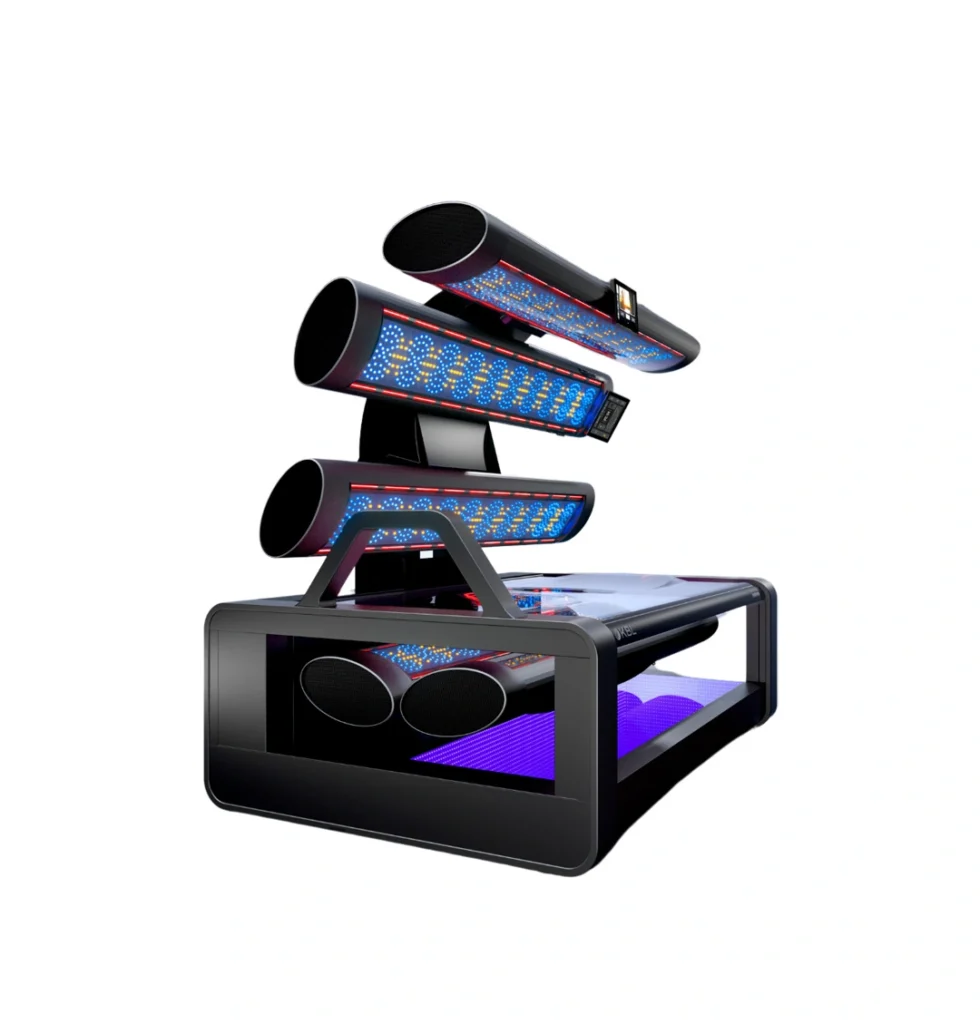
Some beds include red-light therapy to stimulate collagen production and improve skin texture. These features complement tanning and provide additional skin health benefits.
10. Warranty and After-Sales Service
Understanding Warranty Coverage
Check what is covered, including lamps, electronics, and structural components. Understand exclusions such as wear and tear or improper use.
Importance of Reliable After-Sales Support
Reliable support ensures quick solutions for part replacements or repairs. Local service centers can save time and reduce shipping hassles.
Checking for Local Service Centers
If importing a unit, confirm local service availability. Consider voltage compatibility, shipping times, and maintenance costs to avoid complications.
Conclusion – Finding the Perfect Tanning Bed
Summary of Key Considerations
Here’s a recap of the 10 major points to keep in mind:
- Type of bed (low vs high pressure, horizontal vs vertical, specialty hybrid).
- Size and space requirements (footprint, clearance, electrical).
- Power and lamp type (wattage, fluorescent vs LED, replacement frequency).
- Skin type compatibility (Fitzpatrick scale, safe session planning).
- Safety features (timers, ventilation, certification, goggles).
- Maintenance and durability (cleanable surfaces, warranty, parts availability).
- Cost and budget (purchase cost + electricity + maintenance + ROI).
- Brand reputation and reviews (trustworthy manufacturers, real user feedback).
- Additional features and technology (comfort enhancements, red-light therapy, smart controls).
- Warranty and after-sales service (coverage details, local service options).
Tips for First-Time Buyers
- Define your tanning habits: usage frequency and number of users.
- Choose a bed slightly above your current need for durability.
- Ensure proper ventilation and electricity supply.
- Always wear protective eyewear and follow timers.
- Start with short sessions and increase gradually.
Final Thoughts on Safe and Effective Tanning
While tanning beds can help you achieve a beautiful glow, UV exposure carries inherent risks. Use beds responsibly, prioritize safety, and monitor your skin. The ideal tanning bed is one that provides effective, even results while maintaining your skin’s health.
FAQ’s
1 Is indoor tanning completely safe?
No, UV exposure from tanning beds can damage skin and increase the risk of skin cancer, even with precautions.
2 What skin type should avoid tanning beds?
Very fair skin types (Fitzpatrick Types I & II) are at higher risk of burns and skin damage.
3 How often should I replace tanning bed lamps?
Lamp replacement depends on usage; even if lamps appear functional, UV output may decline over time.
4 What additional features are worthwhile?
Comfort features like Bluetooth, aromatherapy, and red-light therapy are optional; safety and lamp quality are priorities




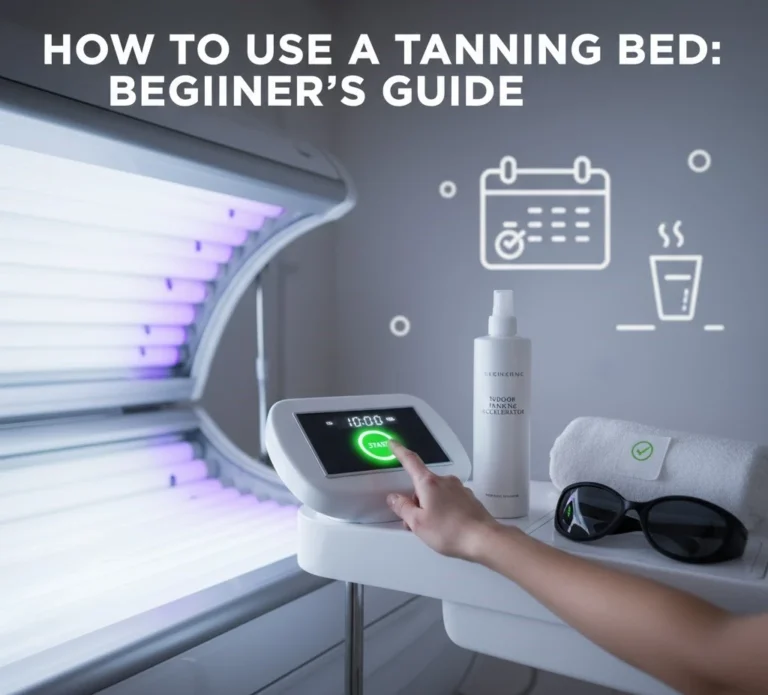
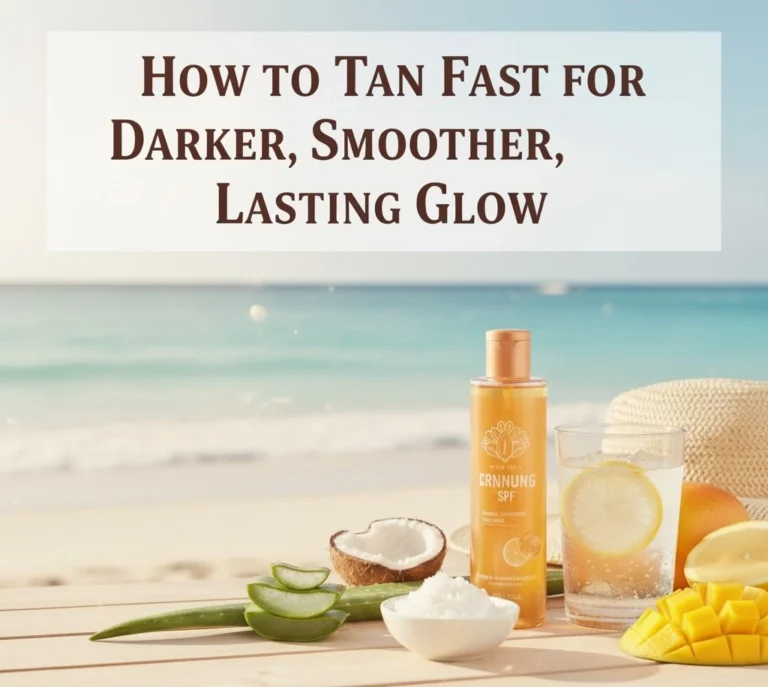

It is actually a great and useful piece of info. I am happy that you shared this helpful information with us. Please stay us up to date like this. Thank you for sharing.
https://www.zoritolerimol.com